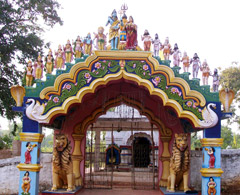Mandaragiri
Spreading over an area of 2,000 acre of forestland 7 km away from the industrial town Angul, Between 20° 47' 15" to 20° 49' 00"N latitude and 85° 1' 30" to 85° 3' 30" E longitude [Ref: Toto sheet no: 73 H-1 [1972-73], Mandaragiri-Kalima reserve forests is a well-known destination for 'vaidyas' and considered as a treasure of biodiversity. Reserve between altitudes of 200 to 1,200 feet, it harbors flora and fauna of socio-economic and ecological importance.
History associated with the hill:
According to local residents, a child named Nepal of Rantalei village went to Mandaragiri hill to graze sheep. He was resting under a tree after a tired journey. A monk asked him to accompany him to the hilltop. The child said he couldn’t do that because he was ill and tired. The monk touched him gently with the hand and the little boy got the energy to get up and accompany him to the hilltop. The boy was worried that his sheep might stray. But the monk assured him that the animals would never go anywhere until they return. The herd of sheep was under the command of the monk. From that day Nepal came to the hilltop from his village, worshiped the Lord and started curing people using medicinal plants available on the hill. He became popular as Nepali Baba.

Palm leaf manuscript:
The vaidyas of all the 9 villages use these palm leaf manuscript to formulate drugs for different diseases and prescribe them for the affected person.
Forest protection and management:
Sharing its forests contiguity with the boundary of Satkoshia Tiger Reserve, once the whole mountain was covered with dense forest but due to lack of protection, large scale felling of trees, the forest lost its coverage and species diversity till 1970. To address the issue of forest fragmentation and degradation, in 1995 the people of the 9 surrounding villages formed Mandargiri Surakshya Mancha and protected the forest using traditional methods of management. Palm‐leaf manuscripts and tried to document it properly so that in future the documentation of the traditional knowledge of the locality can be of the greater importance to the community
Ecosystem services provided by Mandargiri:
Mandaragiri ecosystem provides provisioning (food, fodder, fuel wood, medicines, mushrooms, wild edible fruits, leafy vegetables, mushrooms, hill stream fishes, sabai grass and timber for house hold uses), regulating (influencing local climate through stable rainfall, water of hill streams originated from the hill are used for irrigation purpose and the leaf litters from forests increase soil fertility) and cultural services (in total 1 lakh people assembled in 4 festivals on Mandaragiri to worship lord Shiva in 4 different seasons as a sign of sacred and cultural believes) for 10,000 people of 9 villages surrounded by the hill. The local people have the belief that the agricultural production and vegetable production has increased considerably due to the availability of water for at least 10 months which is a result of active forest protection and management. All the streams of Mandaragiri feeds to Derajanaga medium irrigation project and Mandragiri RF is the catchment area of Derajanga medium irrigation project which is a life line of Angul both for irrigation and drinking water. Recently the Derajanga medium irrigation project is declared as a tourist place by honorable mister of tourism & culture
Socio-cultural belongings associated with Mandargiri:

The hill range has a sprawling forest with many rare and threatened medicinal plants, perennial water sources and wildlife. There are many caves inside the hill, which are treated as sacred places of worship by the local people. The hill comes alive during Shivratri, Magha Saptami, Ram Navami and Makar Sankranti when approximately 2 lakh people assembled here to worship lord shiva in different occasions. On February last week to March 1st week (9 days) of each year, every day around 30,000 people assembled on the hill top of Mandaragiri to worship lord Shiva in the festival called Maghamela (Ananta Sayana of lord Shiva). In Rama Navami, 4000 people assembled at Musapapuli village. On 1st January ever ear 20,000 people assembled in Tumuni temple (Siva) of Tumuni village which is at foothill of Mandaragiri. Similarly in Makara Sankranti, 5000 people assembled in village Saradhapur to worship lord Shiva. Every year (during August-October) villagers from all 9 villages climb up the mountain and when they limb down they pick leaves for their cattle, goats and buffalos and feed them these leaves with a believe that their domestic animals will be healthy throughout the year. Another unique association of women with Mandaragiri is that only women of the 9 villages go to hill top during the month of September every year to worship Lord Shiva. There are three number of caves of prehistoric age and a temple on the top of the mountain while a cluster of temples are found around downhill. The caves are very old and people believe one cave to be the abode of the snake Ananta, while the rest as the seats of mediation of the old saints such as Rushyasrunga and Parsuram
Biodiversity of the hill:
The locals have documented the biological diversity of the hill with support from social scientists, anthropologists, ecologists and wildlife experts to prepare the biodiversity register as per the guideline of the National Biodiversity Authority, India. The tropical dry deciduous forests of the hill are an abode of many flora and fauna of socio-economic and ecological significance. The biodiversity of the hill consists of 569 species of plants belongs to 104 families and 358 genera that includes 279 herbs, 79 shrubs, 140 trees, 63 climbers and 8 epiphytes and 215 species of animals that includes 24 species of mammals, 73 species of birds, 34 species of Reptiles (19 species of snakes, 10 species of lizards and 3 species of turtles and 2 species of tortoise), 13 species of amphibians and 71 species of butterflies. Hill myna, Grey hornbills and lizards such as Termite hill gecko and reptiles such as Python and common cobra are found here.
Healing potential of Mandaragiri:
Mandaragiri is well known for its medicinal plants as the villagers have documented the use of 169 species of plants to cure different kinds of diseases and ailments (both human and domesticated animals) in the form of a PBR. Out of 41 medicinal plants identified under varying degree of threats by FRLHT, Bangalore in CAMP (Conservation Assessment of Medicinal Plants) Workshop, 2008, Mandaragiri harbors 18 species. They are Celastrus paniculatus, Gloriosa superba, Stereospermum chelonoides, Cycas sphaerica, Pterocarpus marsupium, Aphanomixis polystachya, Oroxylum indicum, Litsea glutinosa, Stemona tuberosa, Strychnus potatorum, Rauwolfia serpentina, Pueraria tuberosa, Scindapsus officinalis, Paederia foeitida, Crataeva magna, Saraca asoca, Symplocos racemosa and Mesua ferea. As per local viadyas named Mr. Akrura Sasmal of Musapapuli, Mr. Dibakar Sahoo of Musapauli village and Mr. Adikanda Das of Chandrabahal, the medicinal plants of Mandarargiri is rich in active compounds for which they prefer to harvest them in a particular time of the day as a part of their sustainable harvesting method of collection.
ACTIVITIES & ACHIVEMENTS
Recognition and Awards
NEWS has received a number of recognition and awards for its environment and wildlife activities in the last five years. The notable awards are : Prakriti Mitra, Citations, shields , certificates and honours. The recognition as Honorary Wildlife Warden by the government of Orissa is remarkable as far as conservation of nature and wildlife is concerned.In addition to this, NEWS has also represented in various agencies like Important Bird Conservation Network (IBCN), Orissa Protected Area Network (OPAN) and Orissa Forest Conservation Network. Other government committees are also duly represented by the society.
